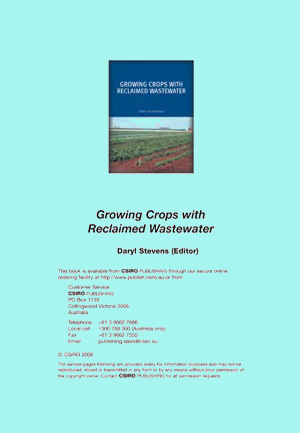|
|
The vast majority of Victorias population resides in the greater Melbourne area and, thus, most wastewater is managed by Melbourne Water through the Western Treatment Plant at Werribee and the South Eastern Purification Plant at Carrum. However, many smaller cities and towns also increasingly face the need to reduce discharge into the marine environment (principally bay and ocean outfall) and freshwater environments through land application or other forms of reuse.
Historical perspective : The Melbourne and Metropolitan Board of Works (MMBW) commenced operation in 1891, and by 1897 the Main Outfall Sewer from Melbourne directed sewerage to the Boards farm at Werribee for treatment prior to the treated effluent being discharged into Port Phillip Bay. Part of this treatment process included land filtration and grass filtration through overland flow. Since 1900, cattle and sheep have grazed the effluent-treated pastures. After paddocks have drained fully following irrigation, livestock are introduced until the next irrigation is due. A presentation in 1978 on the utilisation of wastewater at Werribee discussed the effective and economic use of wastewater by land filtration, grass filtration (overland flow) and lagooning. This report also described research underway to determine the practicability and economics of using treated effluent for irrigation of high value agricultural and horticultural crops including cereal and oilseed, forage crops and various vegetable rotations. In 1975, the South Eastern Purification Plant was commissioned at Carrum to service the eastern and southern parts of greater Melbourne leaving the Werribee Farm to service the other needs of Melbourne. At the South Eastern Purification Plant the wastewater is treated by an activated sludge process and the secondary treated effluent is principally discharged into Bass Strait at Boags Rocks near Cape Schank. Some diversion of the secondary treated effluent has been directed onto areas of recreational turf (eg golf courses, parks and gardens) and some market gardens. Restrictions on market gardening use ensured that the reclaimed water (Class C) did not come into direct contact with produce that may be consumed raw. Summary : In Victoria, treated wastewater has been used in agricultural production systems for more than 100 years at the MMBW farm at Werribee. In more recent times, secondary treated wastewater from authorities such as the South Eastern Purification Plant at Carrum, and Barwon Water at Black Rock Sewage Treatment Plant, has been successfully demonstrated to be safe for use in some vegetable production. However, even though low risk uses of secondary treated effluent have been identified and access to these wastewaters is assured, the rate of acceptance of this option by industry has not been great relative to the volume of wastewater available. Now there are clear and safe guidelines for the various classes of reclaimed water (wastewater), there is scope for a vast increase in the use of reclaimed water for agricultural and horticultural production. With the increasing price of high quality irrigation waters and progressive water shortages to meet the increasing demands for agricultural and horticultural production, it is anticipated that reclaimed water will be seen as an increasingly viable option for profitable and environmentally sustainable production. |
|||||||||
|

